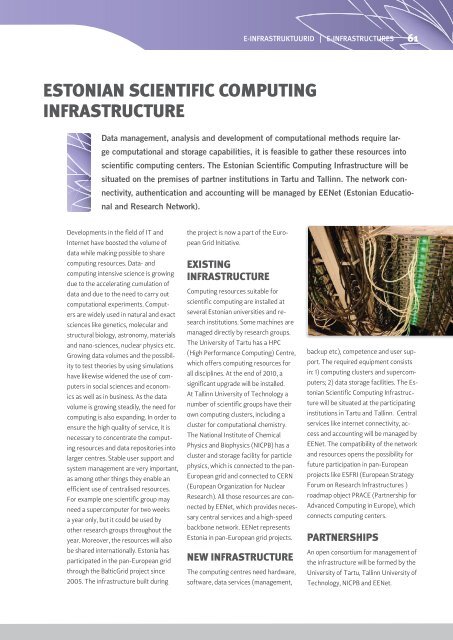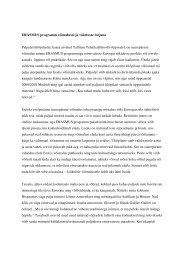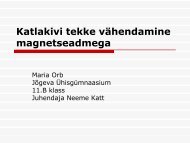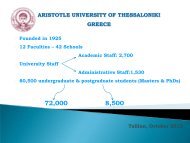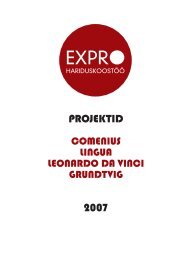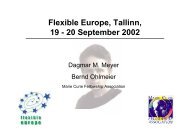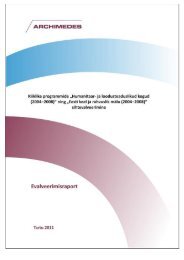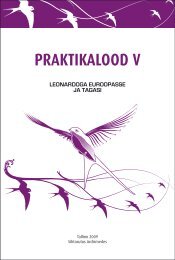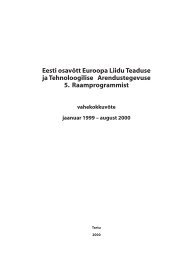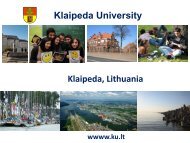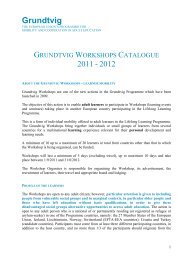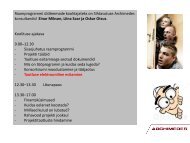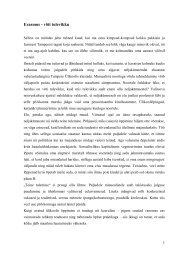Eesti teaduse infrastruktuuride teekaart - ETIS
Eesti teaduse infrastruktuuride teekaart - ETIS
Eesti teaduse infrastruktuuride teekaart - ETIS
- No tags were found...
Create successful ePaper yourself
Turn your PDF publications into a flip-book with our unique Google optimized e-Paper software.
E-INFRASTRUKTUURID | E-INFRASTRUCTURES 61ESTONIAN SCIENTIFIC COMPUTINGINFRASTRUCTUREData management, analysis and development of computational methods require largecomputational and storage capabilities, it is feasible to gather these resources intoscientific computing centers. The Estonian Scientific Computing Infrastructure will besituated on the premises of partner institutions in Tartu and Tallinn. The network connectivity,authentication and accounting will be managed by EENet (Estonian Educationaland Research Network).Developments in the field of IT andInternet have boosted the volume ofdata while making possible to sharecomputing resources. Data- andcomputing intensive science is growingdue to the accelerating cumulation ofdata and due to the need to carry outcomputational experiments. Computersare widely used in natural and exactsciences like genetics, molecular andstructural biology, astronomy, materialsand nano-sciences, nuclear physics etc.Growing data volumes and the possibilityto test theories by using simulationshave likewise widened the use of computersin social sciences and economicsas well as in business. As the datavolume is growing steadily, the need forcomputing is also expanding. In order toensure the high quality of service, it isnecessary to concentrate the computingresources and data repositories intolarger centres. Stable user support andsystem management are very important,as among other things they enable anefficient use of centralised resources.For example one scientific group mayneed a supercomputer for two weeksa year only, but it could be used byother research groups throughout theyear. Moreover, the resources will alsobe shared internationally. Estonia hasparticipated in the pan-European gridthrough the BalticGrid project since2005. The infrastructure built duringthe project is now a part of the EuropeanGrid Initiative.EXISTINGINFRASTRUCTUREComputing resources suitable forscientific computing are installed atseveral Estonian universities and researchinstitutions. Some machines aremanaged directly by research groups.The University of Tartu has a HPC(High Performance Computing) Centre,which offers computing resources forall disciplines. At the end of 2010, asignificant upgrade will be installed.At Tallinn University of Technology anumber of scientific groups have theirown computing clusters, including acluster for computational chemistry.The National Institute of ChemicalPhysics and Biophysics (NICPB) has acluster and storage facility for particlephysics, which is connected to the pan-European grid and connected to CERN(European Organization for NuclearResearch). All those resources are connectedby EENet, which provides necessarycentral services and a high-speedbackbone network. EENet representsEstonia in pan-European grid projects.NEW INFRASTRUCTUREThe computing centres need hardware,software, data services (management,backup etc), competence and user support.The required equipment consistsin: 1) computing clusters and supercomputers;2) data storage facilities. The EstonianScientific Computing Infrastructurewill be situated at the participatinginstitutions in Tartu and Tallinn. Centralservices like internet connectivity, accessand accounting will be managed byEENet. The compatibility of the networkand resources opens the possibility forfuture participation in pan-Europeanprojects like ESFRI (European StrategyForum on Research Infrastructures )roadmap object PRACE (Partnership forAdvanced Computing in Europe), whichconnects computing centers.PARTNERSHIPSAn open consortium for management ofthe infrastructure will be formed by theUniversity of Tartu, Tallinn University ofTechnology, NICPB and EENet.


